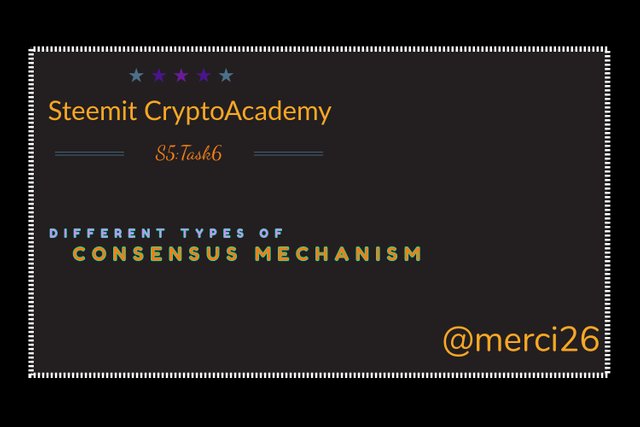Crypto Academy Season 5 Beginners Course- Task 6: Different Types of Consensus Mechanisms

designed by @merci26 using desygner
(1) What is the difference between PoW & PoS? Advantages & Disadvantages? Which one is better in scaling Capacity? Examples?
PROOF OF WORK


PROOF OF STAKE

In PoS, what the validator receives is network fees as reward.
The first cryptocurrency to implement a full-scale PoS consensus model was the Peercoin.

The differences between proof of work and proof of stake includes;

| PoW | PoS |
|---|---|
| Proof of work uses the acronym PoW | while proof of stake uses the acronym PoS. |
| PoW involves mining | while PoS involves Staking. |
| In PoW the person(s) carrying out the work are called Miners | while in PoS persons staking are called Validators |
| In PoW, a reward is given to the first miner who solves a cryptographic puzzle of each block | while in PoS the validator receives network fees as reward. |
| PoW are less energy efficient | while PoS are more energy efficient. |
| PoW requires less capital | while PoS requires more capital |
| PoW require specialized equipment for optimum processing power | while PoS require just standard serves. |
| PoW has limitations of scalability, DeFi products, smart contracts etc | while PoS was created to address this limitations. |

ADVANTAGES OF POW

It serves as a major mechanism to achieve consensus. Without PoW, there would have been abuse or misuse of the Blockchain.
It also helps in the authenticating of transactions thereby preventing individuals from tampering with the database.
It provides a decentralised method of verifying transactions.
It allows miners to earn rewards in the form of cryptocurrencies and some gas fees.
It provides high level of security.
It requires less financial capital when compared to PoS.

DISADVANTAGES OF PoW

It requires high amount of power.
It has negative environmental impacts.
The transaction speeds are slow with high gas fees.
The minings are tedious with advanced hardwares.
There's the problem of scalability.
As newly minted cryptocurrencies near their cap it results to long-term disincentives to mining.

ADVANTAGES OF PoS

They are very energy efficient as they don't require the problems of computational powers.
They offer better rewards for stackers.
They provide fast transactions with low gas fees.
Validators don't require special equipment to stake their cryptocurrency.
There's no problem of scalability.
They offer less negative environmental impacts.

DISADVANTAGES OF PoS

1.They have models which generally results in a less decentralised network.
Proof of stake models are less secure and can be susceptible to low-cost attacks.
Validators with large holdings can have excessive influence on transaction verification as they receive most of the rewards.
It hasn't proved to be sustainable in the long run.
The system doesn't provide for equity as it only makes the rich to get richer.
It's system is harder to implement.

SCABILITY


Examples of cryptocurrencies that use PoS include;

- EOS (EOS)
- Tezos (XTZ)
- Ethereum (ETH 2.0)
- Binance (BNB)
- Cardano (ADA)
- Akash Network (AKT token)
- Cosmos (ATOM)
- Raydium (RAY)
- Lisk (LSK)
- Decentral Games ($DG)
- Private Instant Verified Transaction (PIVX)

CONCLUSION

@steemcurator02 @sapwood my work will be expiring in few hours and it is still not curated
@steemcurator02 my work is yet to be voted